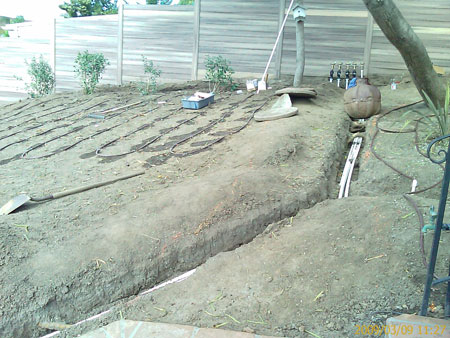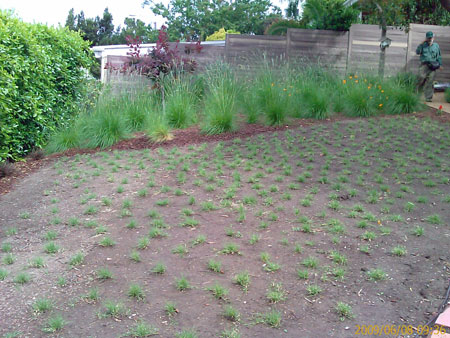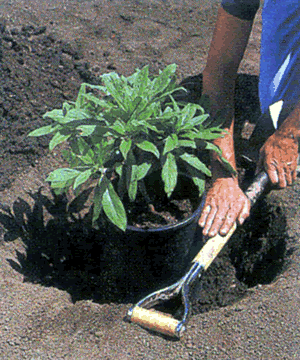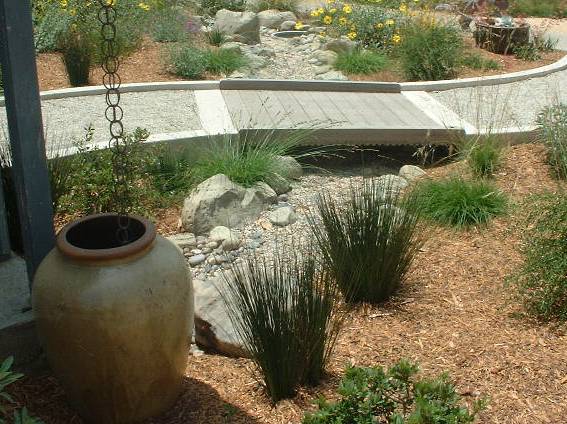|
Installing the Garden
Generally the best time to install a garden is from fall to spring when you can take advantage of seasonal rain. However, it is also advisable to avoid planting and cement work on extremely hot days. The plants will wilt and the cement may crack.
Before you plant, we have provided tips to help avoid costly and time-consuming mistakes.
•
|
Plan for adequate access for each phase of the work.
|
•
|
Provide a staging area for material (sand, bricks, etc.) storage.
|
•
|
Organize the work in such a way that completed areas will not be damaged or disturbed by work in a later phase.
|

Landscape under construction.

After construction
•
|
Decide how you want to maintain unfinished parts of your garden until completed — remember, completion may not be for another year or more.
|
•
|
If budget and/or time constraints are a consideration, install your garden in phases that span over a few years. This allows you to organize, budget construction materials, and work as money becomes available.
|
•
|
Cut grass and weeds and compost the clippings.
|
•
|
Give away unwanted shrubs and trees (check with neighbors or donate to your local school).
|
•
|
Break up unwanted paths and areas of paving. Store and reuse this material, if needed.
|
|
To preserve plants that cannot be immediately placed in the desired location, a temporary planting, preferably during dormancy (late autumn to early spring), will be necessary. Dig up and prepare an area to heel-in (place in a temporary hole) the plant that is to be preserved. Keep plants watered and fed.
|
|
Use a mechanical digger to excavate foundations for walls, paving, and garden buildings. Dig holes for trees if access is likely to be limited later.
|
•
|
Before you dig, check with your planning department for soil removal and disposal procedures.
|
|
Retain and stockpile any quality topsoil that can be used for ground leveling, raised beds, and/or backfilling behind retaining walls.
|
|
Lay sections of plastic pipe (PVC) to act as conduits beneath paving and pathways to allow for water pipes, electric cables, and irrigation supply lines. They can be fed through at a later date. Trench for irrigation lines, and electric cable at the same time. Be sure to check with city and/or county building departments for codes involving the safe separation of electric cables from the water lines. If you need to pass lines under an existing pavement, tunnel a hole under the paving, insert a polyvinyl chloride (PVC) sleeve, then pass the lines through the sleeve.
|
•
|
Lay out areas where paving, or any construction of brick, concrete, or stone will be placed.
|
|
If you plan to grow climbing vines on walls, insert vine eyes (metal screws with hooks) into the wall during construction.
|
•
|
Check with your planning department before building wooden structures (fences, pergolas, trellises, sheds, and decks). Often, it is illegal to build these structures without a permit.
|
|
Cover planting beds, lawn areas, and topsoil stockpile with filter fabric to prevent weed seeds from entering the area and germinating. If you are unable to get filter fabric, use wet newspaper layered with redwood bark.
|
•
|
Complete the irrigation and garden lighting systems. Test all systems.
|
•
|
Apply a pre-emergent to all planned lawn areas before laying sod and follow manufacturer’s specifications.
|
Planting:
•
|
Dig a rough-sided, bell-shaped planting hole, twice as wide as the original rootball. The depth of the hole for a one gallon plant or smaller should be 1 inch shallower than the rootball and 2 inches shallower than the rootball for any plant over 1 gallon. Set plant container in hole. Lay shovel handle across hole to check rootball height. Adjust height if necessary.
|
•
|
Fill hole with water to soak surrounding soil, then knock plant out of its container, loosen tightly knit roots, and set it in the hole. One-gallon plants should be about 1 inch above ground.
|
•
|
Fill hole halfway with backfill. Double-check the elevation of the rootball top and adjust if necessary. Water and allow soaking. Finish backfilling; build a basin and water again.
|

Double check plant height before adding water.
After planting:
•
|
Apply a pre-emergent to all planting areas except lawn and follow manufacturer’s specifications.
|
•
|
Add a 2-inch layer of mulch over the rootball – do not pile it against the stem.
|

Mulched bed.
|
